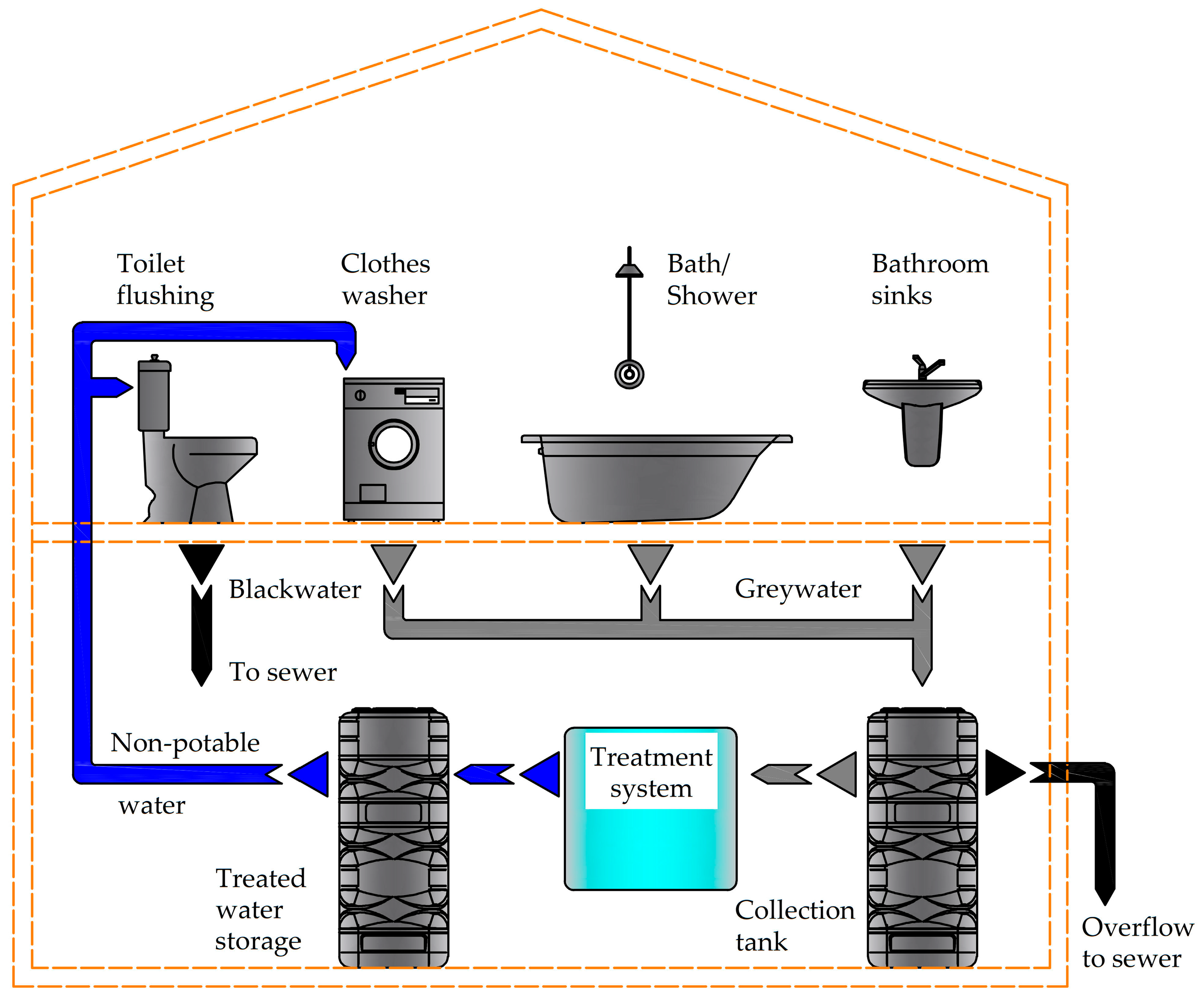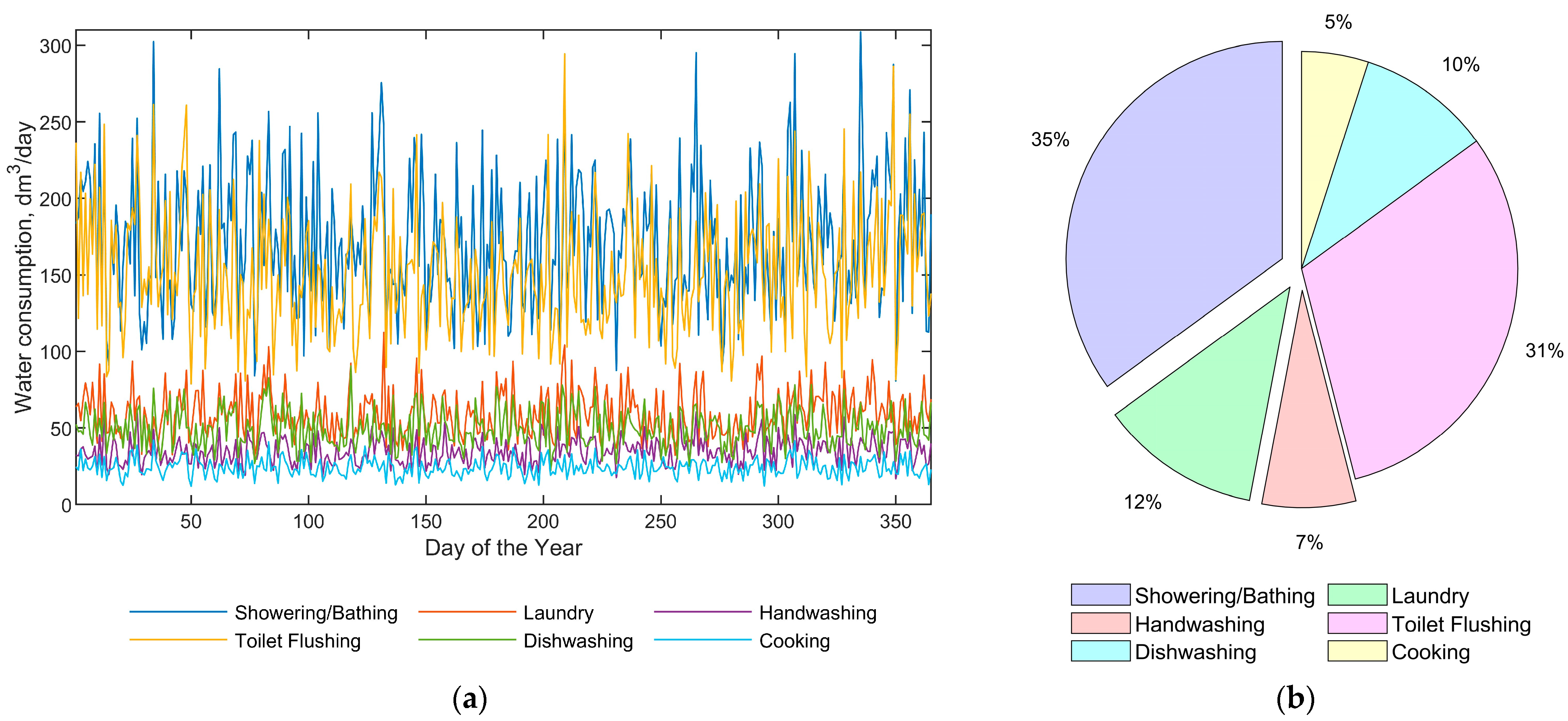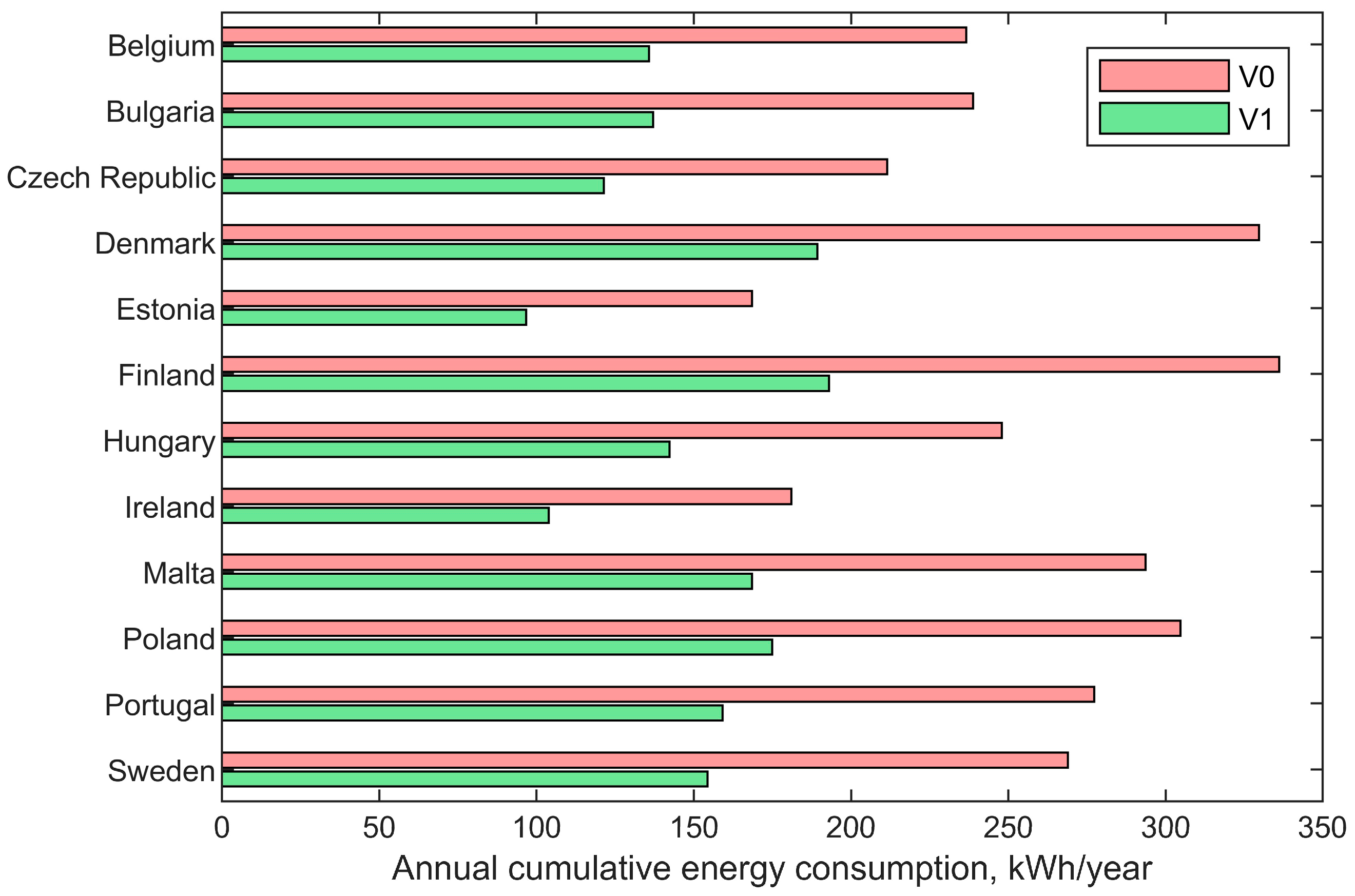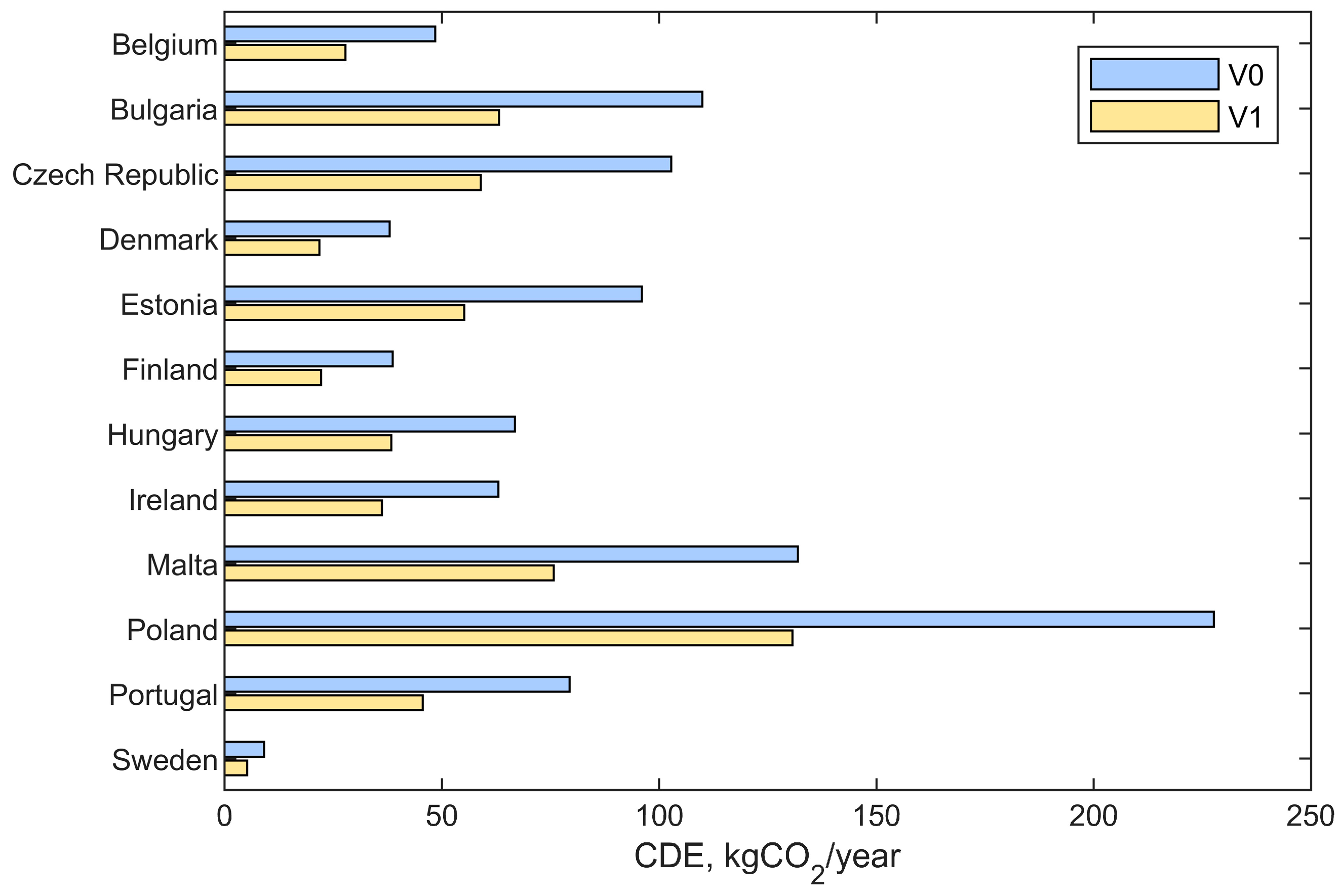Analysis of Greywater Recovery Systems in European Single-Family Buildings: Economic and Environmental Impacts
Abstract
1. Introduction
- ▪ potable water conservation;
- ▪ economic feasibility;
- ▪ energy consumption;
- ▪ environmental impact.
- ▪ How does greywater recovery contribute to sustainable water management in single-family houses?
- ▪ What are the economic, environmental, and energy consumption implications of adopting GRS compared to conventional water use strategies?
2. Materials and Methods
2.1. Integrating Greywater Recycling into Building Design
2.2. Daily Water Consumption Profile
2.3. Financial Analysis
2.4. Determining Energy Consumption and Carbon Dioxide Emissions
2.5. Limitations of Used Input Data
3. Results and Discussion
3.1. Comparative Analysis of Potable Water Consumption
3.2. Comparative Analysis of Economic Viability
3.3. Comparative Analysis of Energy Consumption
3.4. Comparative Analysis of CDE
3.5. Discussion with Other Studies
4. Conclusions
- GRSs significantly reduce potable water demand, up to 43.0% per user, compared to traditional systems;
- Positive NPV is observed in countries such as Belgium, Germany, Denmark, Finland, and Norway, according to the base scenario;
- The implementation of subsidies can reduce the PBP, enhancing economic incentives for adopting GRSs;
- Significant energy savings of up to 42.60% are observed with the use of GRSs;
- Notable reductions in CDEs, with reductions directly proportional to the decreases in energy use;
- The highest CDE reduction was observed in Poland, from 227.65 to 130.68 kgCO2/year.
Author Contributions
Funding
Institutional Review Board Statement
Informed Consent Statement
Data Availability Statement
Conflicts of Interest
Nomenclature
| CDE | Carbon dioxide emission, kgCO2/year |
| CDEF | Carbon dioxide emission factor, kgCO2/kWh |
| Euse | Electric energy demand, kWh/year |
| EFcumulative | Cumulative energy consumption factor for the extraction, treatment, and distribution of drinking water, and for the collection and treatment of wastewater, kWh/m3 |
| GW | Greywater |
| GRS | Greywater recovery system |
| LCC | Life cycle cost, EUR |
| NPV | Net present value, EUR |
| PBP | Payback period, year |
| V | Water consumption, dm3/day |
References
- Boretti, A.; Rosa, L. Reassessing the Projections of the World Water Development Report. NPJ Clean Water 2019, 2, 15. [Google Scholar] [CrossRef]
- United Nations. The United Nations World Water Development Report 2023: Partnerships and Cooperation for Water; UNESCO: Paris, France, 2023. [Google Scholar]
- Mannan, M.; Al-Ghamdi, S.G. Environmental Impact of Water-Use in Buildings: Latest Developments from a Life-Cycle Assessment Perspective. J. Environ. Manag. 2020, 261, 110198. [Google Scholar] [CrossRef] [PubMed]
- Shaikh, I.N.; Ahammed, M.M. Quantity and Quality Characteristics of Greywater: A Review. J. Environ. Manag. 2020, 261, 110266. [Google Scholar] [CrossRef] [PubMed]
- Kordana-Obuch, S.; Starzec, M.; Wojtoń, M.; Słyś, D. Greywater as a Future Sustainable Energy and Water Source: Bibliometric Mapping of Current Knowledge and Strategies. Energies 2023, 16, 934. [Google Scholar] [CrossRef]
- Elhegazy, H.; Eid, M.M.M. A State-of-the-Art-Review on Grey Water Management: A Survey from 2000 to 2020s. Water Sci. Technol. 2020, 82, 2786–2797. [Google Scholar] [CrossRef] [PubMed]
- Stec, A.; Kordana, S. Analysis of Profitability of Rainwater Harvesting, Gray Water Recycling and Drain Water Heat Recovery Systems. Resour. Conserv. Recycl. 2015, 105, 84–94. [Google Scholar] [CrossRef]
- Leong, J.Y.C.; Oh, K.S.; Poh, P.E.; Chong, M.N. Prospects of Hybrid Rainwater-Greywater Decentralised System for Water Recycling and Reuse: A Review. J. Clean. Prod. 2017, 142, 3014–3027. [Google Scholar] [CrossRef]
- Chen, W.; Gao, W.; Wei, X.; Gong, Y. Economic Analysis of Hybrid Rainwater-Greywater Systems between Demand and Supply Sides Based on Cooperative Theory. J. Clean. Prod. 2023, 382, 135283. [Google Scholar] [CrossRef]
- Stec, A.; Słyś, D. Financial and Social Factors Influencing the Use of Unconventional Water Systems in Single-Family Houses in Eight European Countries. Resources 2022, 11, 16. [Google Scholar] [CrossRef]
- Muthukumaran, S.; Baskaran, K.; Sexton, N. Quantification of Potable Water Savings by Residential Water Conservation and Reuse—A Case Study. Resour. Conserv. Recycl. 2011, 55, 945–952. [Google Scholar] [CrossRef]
- Oviedo-Ocaña, E.R.; Dominguez, I.; Ward, S.; Rivera-Sanchez, M.L.; Zaraza-Peña, J.M. Financial Feasibility of End-User Designed Rainwater Harvesting and Greywater Reuse Systems for High Water Use Households. Environ. Sci. Pollut. Res. 2018, 25, 19200–19216. [Google Scholar] [CrossRef] [PubMed]
- Van de Walle, A.; Kim, M.; Alam, M.K.; Wang, X.; Wu, D.; Dash, S.R.; Rabaey, K.; Kim, J. Greywater Reuse as a Key Enabler for Improving Urban Wastewater Management. Environ. Sci. Ecotechnol. 2023, 16, 100277. [Google Scholar] [CrossRef] [PubMed]
- Oron, G.; Adel, M.; Agmon, V.; Friedler, E.; Halperin, R.; Leshem, E.; Weinberg, D. Greywater Use in Israel and Worldwide: Standards and Prospects. Water Res. 2014, 58, 92–101. [Google Scholar] [CrossRef] [PubMed]
- Vuppaladadiyam, A.K.; Merayo, N.; Prinsen, P.; Luque, R.; Blanco, A.; Zhao, M. A Review on Greywater Reuse: Quality, Risks, Barriers and Global Scenarios. Rev. Environ. Sci. Biotechnol. 2019, 18, 77–99. [Google Scholar] [CrossRef]
- Jeong, H.; Broesicke, O.A.; Drew, B.; Crittenden, J.C. Life Cycle Assessment of Small-Scale Greywater Reclamation Systems Combined with Conventional Centralized Water Systems for the City of Atlanta, Georgia. J. Clean. Prod. 2018, 174, 333–342. [Google Scholar] [CrossRef]
- Naserisafavi, N.; Yaghoubi, E.; Sharma, A.K. Alternative Water Supply Systems to Achieve the Net Zero Water Use Goal in High-Density Mixed-Use Buildings. Sustain. Cities Soc. 2022, 76, 103414. [Google Scholar] [CrossRef]
- Lam, C.-M.; Leng, L.; Chen, P.-C.; Lee, P.-H.; Hsu, S.-C. Eco-Efficiency Analysis of Non-Potable Water Systems in Domestic Buildings. Appl. Energy 2017, 202, 293–307. [Google Scholar] [CrossRef]
- EurEau. Europe’s Water in Figures: An Overview of the European Drinking Water and Waste Water Sectors; The European Federation of National Associations of Water Services: Brussels, Belgium, 2021. [Google Scholar]
- Yateh, M.; Li, F.; Tang, Y.; Li, C.; Xu, B. Energy Consumption and Carbon Emissions Management in Drinking Water Treatment Plants: A Systematic Review. J. Clean. Prod. 2024, 437, 140688. [Google Scholar] [CrossRef]
- EN 16941-2:2021; On-Site Non-Potable Water Systems–Part 2: Systems for the Use of Treated Greywater. European Committee for Standardization: Brussels, Belgium, 2021.
- Willis, R.M.; Stewart, R.A.; Giurco, D.P.; Talebpour, M.R.; Mousavinejad, A. End Use Water Consumption in Households: Impact of Socio-Demographic Factors and Efficient Devices. J. Clean. Prod. 2013, 60, 107–115. [Google Scholar] [CrossRef]
- Englart, S.; Jedlikowski, A. The Influence of Different Water Efficiency Ratings of Taps and Mixers on Energy and Water Consumption in Buildings. SN Appl. Sci. 2019, 1, 525. [Google Scholar] [CrossRef]
- Mazzoni, F.; Alvisi, S.; Blokker, M.; Buchberger, S.G.; Castelletti, A.; Cominola, A.; Gross, M.-P.; Jacobs, H.E.; Mayer, P.; Steffelbauer, D.B.; et al. Investigating the Characteristics of Residential End Uses of Water: A Worldwide Review. Water Res. 2023, 230, 119500. [Google Scholar] [CrossRef] [PubMed]
- Lauruschkus, F.; Meermann, K.; Bürger, K.; Albrecht, H. VEWA-Comparison of European Water and Wastewater Prices; BDEW, German Association of Energy and Water Industries: Berlin, Germany, 2015; Available online: https://www.lebensraumwasser.com/wp-content/uploads/2019/10/BDEW_VEWA_Study_English_20150423.pdf (accessed on 30 May 2024).
- Sarkar, D. Life Cycle Costing Analysis of Grey Water Recycling Systems for Commercial and Residential Projects of Ahmedabad, India. Mater. Today Proc. 2023, 77, 254–259. [Google Scholar] [CrossRef]
- Zib, L.; Byrne, D.M.; Marston, L.T.; Chini, C.M. Operational Carbon Footprint of the U.S. Water and Wastewater Sector’s Energy Consumption. J. Clean. Prod. 2021, 321, 128815. [Google Scholar] [CrossRef]
- Scarlat, N.; Prussi, M.; Padella, M. Quantification of the Carbon Intensity of Electricity Produced and Used in Europe. Appl. Energy 2022, 305, 117901. [Google Scholar] [CrossRef]
- Leong, J.Y.C.; Balan, P.; Chong, M.N.; Poh, P.E. Life-Cycle Assessment and Life-Cycle Cost Analysis of Decentralised Rainwater Harvesting, Greywater Recycling and Hybrid Rainwater-Greywater Systems. J. Clean. Prod. 2019, 229, 1211–1224. [Google Scholar] [CrossRef]
- Yu, Z.L.T.; Deshazo, J.R.; Stenstrom, M.K.; Cohen, Y. Cost–Benefit Analysis of Onsite Residential Graywater Recycling: A Case Study on the City of Los Angeles. J. AWWA 2015, 107, E436–E444. [Google Scholar] [CrossRef]
- Juan, Y.-K.; Chen, Y.; Lin, J.-M. Greywater Reuse System Design and Economic Analysis for Residential Buildings in Taiwan. Water 2016, 8, 546. [Google Scholar] [CrossRef]









| Parameter | Value | Description |
|---|---|---|
| Greywater recovery system (GRS) | 5000.00 EUR | Average of quotations received from manufacturers |
| Dual plumbing system | 1000.00 EUR | Additional costs for a newly constructed building |
| Annual operational cost | 40.00 EUR | Based on electricity consumption data |
| Annual growth of operational costs | 3.00% | Assumed based on historical data |
| Water and sewage prices | 1.23–9.32 EUR | [19,25] |
| Annual growth of water/sewage prices | 3.00% | Assumed based on historical data |
| Analysis period (t) | 20 years | Assumed system lifespan |
| Discount rate (r) | 5.00% | [10] |
| Annual Household Water Consumption, m3/Year | ||||||||||||
|---|---|---|---|---|---|---|---|---|---|---|---|---|
| 125.0 | 150.0 | 175.0 | 200.0 | |||||||||
| LCC20 | PBP | LCC20 | PBP | LCC20 | PBP | LCC20 | PBP | |||||
| V0 | V1 | V0 | V1 | V0 | V1 | V0 | V1 | |||||
| Belgium | 10,736 | 12,758 | 35 | 12,884 | 13,982 | 26 | 15,031 | 15,206 | 21 | 17,178 | 16,430 | 18 |
| Denmark | 18,599 | 17,240 | 16 | 22,319 | 19,360 | 13 | 26,039 | 21,480 | 11 | 29,758 | 23,600 | 9 |
| Finland | 10,896 | 12,849 | 34 | 13,075 | 14,091 | 25 | 15,254 | 15,333 | 21 | 17,434 | 16,575 | 17 |
| Germany | 11,475 | 13,179 | 31 | 13,770 | 14,487 | 24 | 16,065 | 15,795 | 19 | 18,360 | 17,103 | 16 |
| Norway | 12,453 | 13,736 | 28 | 14,943 | 15,156 | 21 | 17,434 | 16,575 | 17 | 19,924 | 17,995 | 15 |
| Annual Increase in Water Supply and Sewage Collection Prices, % | |||||||||
|---|---|---|---|---|---|---|---|---|---|
| 2.0 | 4.0 | 6.0 | |||||||
| LCC20 | PBP | LCC20 | PBP | LCC20 | PBP | ||||
| V0 | V1 | V0 | V1 | V0 | V1 | ||||
| Belgium | 14,202 | 14,734 | 23 | 16,868 | 16,254 | 18 | 20,214 | 18,161 | 16 |
| Denmark | 24,603 | 20,662 | 11 | 29,222 | 23,295 | 10 | 35,017 | 26,599 | 9 |
| Finland | 14,413 | 14,854 | 23 | 17,119 | 16,397 | 18 | 20,515 | 18,332 | 16 |
| Germany | 15,179 | 15,290 | 21 | 18,029 | 16,915 | 17 | 21,604 | 18,953 | 15 |
| Netherlands | 11,219 | 13,033 | 35 | 13,325 | 14,234 | 24 | 15,968 | 15,741 | 20 |
| Norway | 16,472 | 16,028 | 19 | 19,565 | 17,791 | 16 | 23,445 | 20,002 | 14 |
| Sweden | 11,905 | 13,425 | 31 | 14,141 | 14,699 | 23 | 16,945 | 16,297 | 19 |
| Switzerland | 12,011 | 13,485 | 31 | 14,266 | 14,770 | 23 | 17,095 | 16,383 | 19 |
| Discount Rate r, % | |||||||||
|---|---|---|---|---|---|---|---|---|---|
| 5.0 | 7.5 | 10.0 | |||||||
| LCC20 | PBP | LCC20 | PBP | LCC20 | PBP | ||||
| V0 | V1 | V0 | V1 | V0 | V1 | ||||
| Belgium | 15,460 | 15,451 | 20 | 12,370 | 13,562 | 30 | 10,120 | 12,187 | – |
| Denmark | 26,783 | 21,905 | 11 | 21,429 | 18,726 | 12 | 17,532 | 16,411 | 15 |
| Finland | 15,690 | 15,582 | 20 | 12,554 | 13,667 | 29 | 10,271 | 12,272 | – |
| Germany | 16,524 | 16,057 | 19 | 13,221 | 14,047 | 26 | 10,816 | 12,583 | – |
| Norway | 17,932 | 16,860 | 17 | 14,347 | 14,689 | 22 | 11,738 | 13,109 | – |
| Value of the Subsidy, EUR | ||||||
|---|---|---|---|---|---|---|
| 1000 | 2000 | |||||
| LCC20 | PBP | LCC20 | PBP | |||
| V0 | V1 | V0 | V1 | |||
| Belgium | 15,460 | 14,451 | 17 | 15,460 | 13,451 | 13 |
| Denmark | 26,783 | 20,905 | 9 | 26,783 | 19,905 | 7 |
| Finland | 15,690 | 14,582 | 16 | 15,690 | 13,582 | 13 |
| France | 11,725 | 12,322 | 24 | 11,725 | 11,322 | 18 |
| Germany | 16,524 | 15,057 | 15 | 16,524 | 14,057 | 12 |
| Netherlands | 12,213 | 12,600 | 23 | 12,213 | 11,600 | 17 |
| Norway | 17,932 | 15,860 | 14 | 17,932 | 14,860 | 11 |
| Sweden | 12,960 | 13,026 | 21 | 12,960 | 12,026 | 16 |
| Switzerland | 13,075 | 13,091 | 21 | 13,075 | 12,091 | 16 |
Disclaimer/Publisher’s Note: The statements, opinions and data contained in all publications are solely those of the individual author(s) and contributor(s) and not of MDPI and/or the editor(s). MDPI and/or the editor(s) disclaim responsibility for any injury to people or property resulting from any ideas, methods, instructions or products referred to in the content. |
© 2024 by the authors. Licensee MDPI, Basel, Switzerland. This article is an open access article distributed under the terms and conditions of the Creative Commons Attribution (CC BY) license (https://creativecommons.org/licenses/by/4.0/).
Share and Cite
Rajski, K.; Englart, S.; Sohani, A. Analysis of Greywater Recovery Systems in European Single-Family Buildings: Economic and Environmental Impacts. Sustainability 2024, 16, 4912. https://doi.org/10.3390/su16124912
Rajski K, Englart S, Sohani A. Analysis of Greywater Recovery Systems in European Single-Family Buildings: Economic and Environmental Impacts. Sustainability. 2024; 16(12):4912. https://doi.org/10.3390/su16124912
Chicago/Turabian StyleRajski, Krzysztof, Sebastian Englart, and Ali Sohani. 2024. "Analysis of Greywater Recovery Systems in European Single-Family Buildings: Economic and Environmental Impacts" Sustainability 16, no. 12: 4912. https://doi.org/10.3390/su16124912
APA StyleRajski, K., Englart, S., & Sohani, A. (2024). Analysis of Greywater Recovery Systems in European Single-Family Buildings: Economic and Environmental Impacts. Sustainability, 16(12), 4912. https://doi.org/10.3390/su16124912








